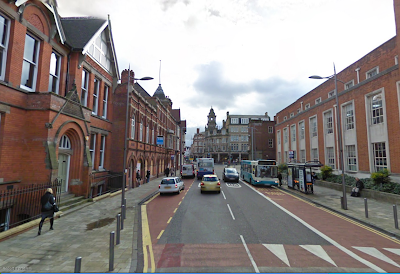Sunday, February 20, 2011
Saturday, February 19, 2011
Friday, February 18, 2011
Wednesday, February 16, 2011
Monday, February 14, 2011
Yay! Earthcam Top Ten! :-)
Saturday, February 12, 2011
Lady Wulfrun
In 985, King Ethelred the Unready granted lands at a place referred to as Heantun to Lady Wulfrun by royal charter, and hence founding the settlement.
Friday, February 11, 2011
The Saxons and Danes
Wolverhampton is recorded as being the site of a decisive battle between the Saxons and Danes in 910, although sources are unclear as to whether the battle itself took place in Wednesfield or Tettenhall. The Saxons claimed a decisive victory and the field of Woden is recognised by numerous place names in Wednesfield.
Thursday, February 10, 2011
Wolverhampton
Wolverhampton is a city and metropolitan borough in the West Midlands, England. In 2004, the local government district had an estimated population of 239,100; the wider Urban Area had a population of 251,462, which makes it the 13th most populous city in England.
Historically a part of Staffordshire, and forming part of the metropolitan county of the West Midlands from 1974, the city is commonly recognised as being named after Lady Wulfrun, who founded the town in 985: its name coming from Anglo-Saxon Wulfrūnehēantūn = "Wulfrūn's high or principal enclosure or farm". Alternatively, the city may have earned its original name from Wulfereēantūn = "Wulfhere's high or principal enclosure or farm" after the Mercian King. Nevertheless, the name Wulfrun is commonly used in the city – for example, for the Wulfrun Centre or for Wulfrun Hall.
The city's name is often abbreviated to Wolvo "W'ton" or "Wolves". The city council's motto is "Out of darkness, cometh light". People from Wolverhampton are known as Wulfrunians.
The city grew initially as a market town with specialism within the woollen trade. During and after the Industrial Revolution, the city became a major industrial centre, with mining (mostly coal, limestone and iron ore) as well as production of steel, japanning, locks, motorcycles and cars – including the first vehicle to hold the Land speed record at over 200 mph. Today, the major industries within the city are both engineering based, including a large aerospace industry, and within the service sector.
Historically a part of Staffordshire, and forming part of the metropolitan county of the West Midlands from 1974, the city is commonly recognised as being named after Lady Wulfrun, who founded the town in 985: its name coming from Anglo-Saxon Wulfrūnehēantūn = "Wulfrūn's high or principal enclosure or farm". Alternatively, the city may have earned its original name from Wulfereēantūn = "Wulfhere's high or principal enclosure or farm" after the Mercian King. Nevertheless, the name Wulfrun is commonly used in the city – for example, for the Wulfrun Centre or for Wulfrun Hall.
The city's name is often abbreviated to Wolvo "W'ton" or "Wolves". The city council's motto is "Out of darkness, cometh light". People from Wolverhampton are known as Wulfrunians.
The city grew initially as a market town with specialism within the woollen trade. During and after the Industrial Revolution, the city became a major industrial centre, with mining (mostly coal, limestone and iron ore) as well as production of steel, japanning, locks, motorcycles and cars – including the first vehicle to hold the Land speed record at over 200 mph. Today, the major industries within the city are both engineering based, including a large aerospace industry, and within the service sector.
Subscribe to:
Posts (Atom)









